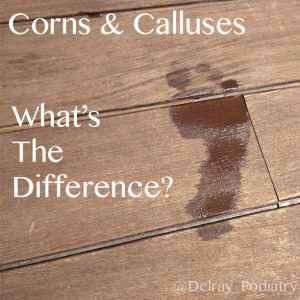While neither likely comes as a welcome sight, it’s important to remember that corns and calluses are not the same.
Yes, both develop from the accumulation of dead skin cells that form thick, hardened areas. And yes, they can also both cause pain and are typically not very pleasant to look at.
There are, however, several general differences between these common skin conditions.
Calluses
– Calluses are commonly found on the ball of the foot, the heel, or the inside of the big toe.
– Calluses form to defend the foot against excessive pressure and friction.
– Calluses do not typically cause pain.
– Calluses can be caused by obesity, abnormalities in your walking motion, flat feet, high arched feet, and the loss of the fat pad on the bottom of the foot.
– Calluses are areas of flat, thickened skin.
– Calluses are thickened from top to bottom.
– Calluses can be removed with a pumice stone or the cutting away of dead skin.
Corns
– Corns are commonly found on the tops, sides and tips of the toes and come in a variety of shapes and sizes.
– A hard corn is a compact patch of hard skin with a dense core, located on top of a toe or the outside of the little toe.
– A soft corn is a reddened, tender area of skin, has a thin, smooth center, and is found between toes.
– A seed corn is a plug-like circle of dead skin, often painful, on the heel or ball of the foots.
– Corns can be caused by tight shoes, high heels, deformed toes, or shoes that slide back and forth because they fit too loosely.
– Corns have cores that point upwards, which can press on nerves and cause pain.
– Corns only have a hard center core.
– Corns can be treated with cushioned pads and proper footwear.
– If Corns persist, a podiatrist may be called upon to remove them.
If you have diabetes or another condition that causes poor blood flow to your feet, you’re at greater risk of complications from corns and calluses. If you believe you are suffering from either condition, consult a doctor in order to properly identity the problem and formulate a treatment plan.
In general, the best way to avoid getting corns and calluses is by wearing proper-fitting shoes. Avoid wearing high heels, and if you want to play it safe, ask your doctor about a custom-made orthotic shoe insert to help maximize both comfort and protection for your feet.
—
Follow Delray Beach Podiatry on Twitter @Delray_Podiatry
The content on this website is for informational purposes only. Do not rely or act upon information from www.DelrayBeachPodiatry.com without seeking professional medical advice. If you live in South Florida and would like a consultation with Dr. Ian Goldbaum, a podiatric physician and surgeon with over 30 years of experience, please see our contact information below:
BOCA/DELRAY
16244 S. Military Trail #290, Delray Beach, FL 33445
561-499-0033
BOYNTON BEACH
8198 Jog Road #100, Boynton Beach, FL 33472
561-499-0033


No responses yet